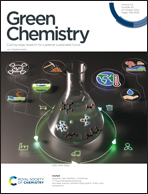Efficient separation of electrode active materials and current collector metal foils from spent lithium-ion batteries by a green deep eutectic solvent†
Abstract
Electrode material separation is an essential element for recycling spent lithium-ion batteries (LIBs), and the key is to decompose/remove the organic polymer binder that is usually polyvinylidene fluoride (PVDF). The density functional theory calculation is used to predict a suitable deep eutectic solvent (DES) for degrading the PVDF binder as required for the effective separation of the electrode active materials from current collector foils. The potassium carbonate–ethylene glycol DES was thus identified as an efficient DES for electrode material separation. Investigation of the molecular reaction mechanism revealed that it was the carbonate ions that reacted with the PVDF polymer chains and caused the degradation of the polymer, leading to effective separation. The electrode materials could be completely separated under mild reaction conditions (100 °C, 20 min), and the DES could be recovered and reused for multiple cycles. The separated electrode materials all had high purities and their crystal structures remained unchanged. The green DES developed in this study provides a highly efficient and environmentally friendly pathway for the pretreatment of spent LIBs.



 Please wait while we load your content...
Please wait while we load your content...